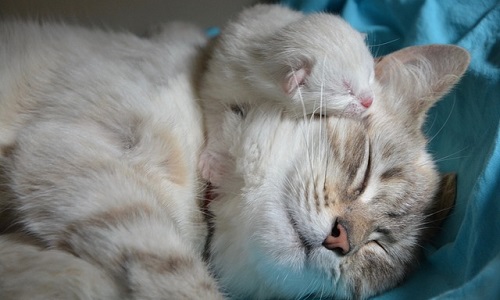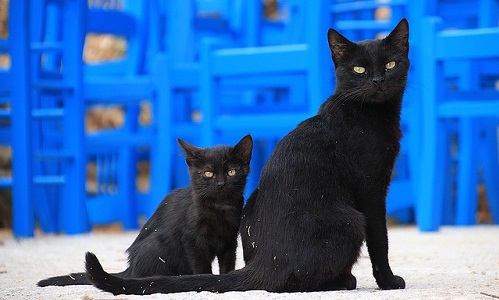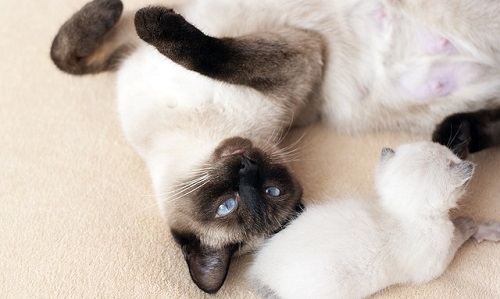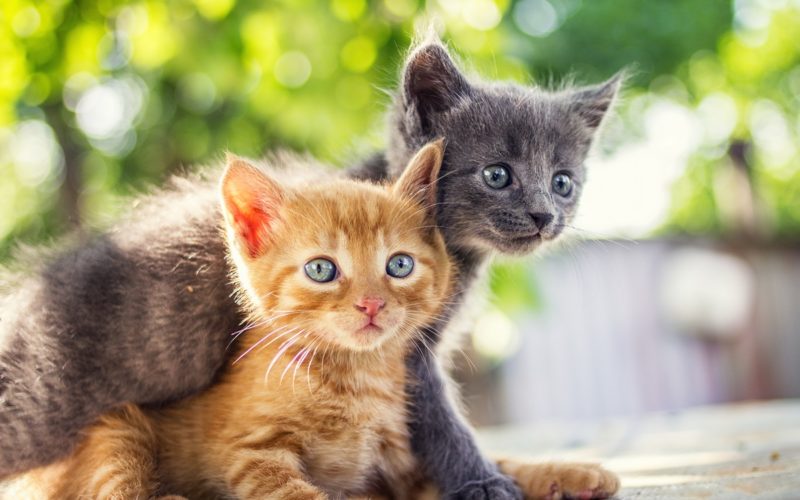Kittens are one of the most universally adored animals, but they can also be a source of stress for a pregnant cat’s human (that’s you!), particularly if that human isn’t sure what to do. Thankfully, cats show their trademark independence in pregnancy.
Female cats have been birthing and caring for kittens since the beginning of feline history but worry not: there’s still a lot you can help with to keep your beloved pet safe, secure, and happy as she becomes a mother.
That journey starts with discovering as much as possible about your four-footed companion as her pregnancy progresses. Unfortunately, there’s a great deal of misinformation about cat pregnancy, particularly regarding how it happens in the first place. If your cat is pregnant, this guide is for you!
Some Common Myths About Cat Pregnancy Include:
- She can’t be pregnant – she just came out of heat! Believe it or not, cats can go into heat – a period of fertility where she will actively, and often loudly, seek out a male companion – every three weeks. That’s not a lot of down time, and it gives her plenty of opportunities to start a surprise feline family. Unlike most other animals with a distinct ovulation cycle, a female cat will continually go into heat throughout the year, until your pet is spayed or becomes pregnant.
- She can’t be pregnant – she just gave birth! As many human mothers has discovered by accident, it’s entirely possible to conceive again, even while lactating. In fact, if left unchecked, a cat can produce up to five litters of kittens every year – that’s a lot of adorable mouths to feed.
- She can’t be pregnant – she and (other cat) hate each other! Simply put, the call of the wild is a strong call indeed. Even if your unspayed female cat and unneutered male cat don’t typically get along, don’t be surprised if they get a little friendlier on the sly once she goes into heat.
- She can’t be pregnant – she’s too young/old! Believe it or not, cats as young as four months old can become pregnant cats. As many owners of older kittens have discovered, there’s almost no age where it’s “safe” to let an unspayed female cat around an unneutered male. Unspayed female cats can become pregnant throughout their lives, as well: there’s no such thing as feline menopause.
How Do I Know If My Cat Is Pregnant?
 As any serial cat owner will attest, kitties can come in a wide variety of shapes and sizes. Knowing the difference between a female cat that has been overindulging in too much wet food and one that’s gestating kittens can be decidedly tricky. Here are a few pointers to tell if your cat is pregnant:
As any serial cat owner will attest, kitties can come in a wide variety of shapes and sizes. Knowing the difference between a female cat that has been overindulging in too much wet food and one that’s gestating kittens can be decidedly tricky. Here are a few pointers to tell if your cat is pregnant:
- Has she had the opportunity to become pregnant? While this may seem like common sense, some owners are so worried about their potentially pregnant cat that they don’t stop to do the math. Has your female cat had access or exposure to an unneutered tom cat recently?
Note: If your cat is indoor/outdoor as opposed to an entirely indoor cat, the answer to this question is an assumed yes! Even if you haven’t seen or heard males, a female cat in heat will go to great (loud) lengths to find or coax them to her.
- Has she been checked for other potential issues, such as worms? Parasitic worms aren’t just bad news for the health of your cat, they can also cause belly bloat that looks suspiciously like pregnancy. Hookworms, tapeworms, and other unwanted “passengers” are typically contracted by exposure to fleas, which carry the worm eggs and infect cats when they are eaten during routine self-grooming.
Note: This is another red flag for indoor/outdoor or entirely-outdoor cats – they are continually exposed to parasites like fleas and ticks in the environment, as well as from fellow outdoor cats. If your cat is regularly treated with a preventative like a topical fluid or pill, the chances of parasites obviously decline considerably.
- Are her nipples darker or larger than usual? You won’t need a magnifying glass for this one: the difference in appearance is usually apparent at a glance if you spend a lot of time with your feline companion. This color and size change will typically show three weeks after conception, so keep an eye on your female cat in the weeks after a temporarily escape or after she’s spent any time around an unneutered tom cat. This symptom is easier to spot in first-time feline mothers, but it’s still visible in subsequent pregnancies.
- Does she appear bigger, particularly along her stomach and sides? Pregnancy naturally comes with weight gain regardless of species, but the way in which your cat carries her extra weight is an instant giveaway. Pregnancy weight will appear prominently along her sides and lower belly, making her body silhouette look disproportionate when you are face-to-face with her.
- Do you feel movement in her stomach? If you feel significant, ongoing movement in her stomach when you place a hand on it, this is a good sign that not only is she pregnant, but very close to giving birth as well. The more active and consistent the movement, the closer to labor she likely is: fetal kittens don’t get large enough to make much of a ruckus until they’re ready to explore the world outside! The common consensus is that by the time you can easily feel kitten movement, your cat is within two weeks of producing her litter.
Of course, the easiest and most foolproof way to determine if your cat is pregnant with kittens is the same one used by humans: verifying with a doctor, or in her case, a veterinarian. A vet can, as a potential cat pregnancy progresses, use ultrasound or expert examination to give you a firm yes or no. As routine checkups for your cat are a good habit anyway, timing a visit this way is a smart and healthy choice for your kitty.
What Do I Do If My Cat Is Pregnant? A Helpful Checklist For Your Cat
 You’ve just gotten the good news: you have a litter of kittens on the way! Well, rather, your cat does. Carrying what will likely be multiple bundles of joy, your cat is now called a queen (yes, really!) and will be pregnant for approximately nine weeks. During your cat’s nine-week pregnancy, her rapidly-gestating offspring – which are collectively called an “intrigue” of kittens in honor of cats’ curious nature, by the way – will need your help to be as strong and healthy as possible.
You’ve just gotten the good news: you have a litter of kittens on the way! Well, rather, your cat does. Carrying what will likely be multiple bundles of joy, your cat is now called a queen (yes, really!) and will be pregnant for approximately nine weeks. During your cat’s nine-week pregnancy, her rapidly-gestating offspring – which are collectively called an “intrigue” of kittens in honor of cats’ curious nature, by the way – will need your help to be as strong and healthy as possible.
She will need:
- Food: Just as humans joke that a pregnant mother is “eating for two,” a pregnant cat is eating for many more: a litter of kittens generally consists of 3 to 5 kittens. That means she’ll need a lot more calories and well-balanced nutrition to support her little ones, particularly as the time for birthing nears. Your veterinarian can recommend a nutritious dry or wet food to feed her, which will support her vitamin, mineral, and energy needs through pregnancy and lactation afterwards. If you can’t get your cat an appointment, select a food brand made specifically for pregnant or nursing cats at the pet store instead.
- Water: Your cat should always have access to fresh, clean water regardless of pregnancy, but it’s particularly important for her to stay hydrated when she’s carrying kittens. Remember, a great deal of her energy is being devoted to growing the little lives inside of her, and that means she’s likely to need more water than usual. Make sure to wash and clean the water bowl daily, and dump and refill the water if dirt, stray cat food, or other contaminants can be seen.
- Peace and Quiet: It’s no accident that pregnant cats are called queens – they can be very finicky and demanding, even as cats go. That’s why it’s important to keep her stress level as low as possible during pregnancy for the safety of her kittens. Be sure she is either isolated from or has a safe space to retreat to in the face of other household pets, children, noise, or a great deal of foot traffic: under a bed, a blanket-lined box, and so on.
- Reassurance: While some cats become or remain aloof and independent even as they are giving birth, others crave the nearness and support of their human companion, and may even delay giving birth to kittens if their human needs to leave at an inopportune stage of the labor. Showing your pregnant cat that you will be there for her with frequent petting, attention, and consideration in the weeks leading up to labor will help her relax and focus on her own well-being.
- A Healthy Environment: Consult with your veterinarian on which flea and tick medications are appropriate for your pregnant cat and keep her inside full time if you don’t already. This will minimize the risks of injuries, predators, and parasites hurting her unborn kittens. Keep potentially poisonous substances like onions and garlic away from her reach to prevent accidental ingestion. Feline nutritional supplements are also an excellent way to support her health at a time when the needs of her growing kittens are putting a large demand on her body’s resources.
The Big Day: What To Do When A Cat Is Giving Birth
The best-laid birthing plans can go awry when a cat is part of the mix, so even if you create an ideal corner or birthing box, she may not use it. The important thing to remember is to let her choose where she is comfortable giving birth, even if it’s a less-than-ideal spot in your home. You can hedge your bets by keeping a supply of old towels or fleece blankets within easy reach of every room. These can be draped or used to protect carpets or furniture from the mess of the birth.
 Right before her kittens make their grand entrance, your feline companion may pace and frantically try to find a safe space to give birth. If you notice your pregnant cat looking agitated while rapidly moving from room to room in late term pregnancy, it’s likely time to spring into action. She will lay on her side and start panting as the labor begins – this is normal and healthy, a side effect of the effort she’s putting into the birth.
Right before her kittens make their grand entrance, your feline companion may pace and frantically try to find a safe space to give birth. If you notice your pregnant cat looking agitated while rapidly moving from room to room in late term pregnancy, it’s likely time to spring into action. She will lay on her side and start panting as the labor begins – this is normal and healthy, a side effect of the effort she’s putting into the birth.
Kittens will emerge one at a time, and it will take between 5 and 30 minutes for each kitten to emerge completely. Your cat will groom each kitten as it arrives and may consume the “afterbirth” – the placenta and sac that arrives with or directly after each kitten. This is normal and healthy, even if it looks a little off-putting! This practice gives cats in the wild a chance to reingest the nutrients they’ll need to nurse.
Unless your cat looks to be in a great deal of pain or frantic, let her birth her kittens and do not interfere with the actual extraction unless there is an emergency. Queens can stop laboring if they feel endangered or threatened and stopping mid-birthing process can be harmful to both mother and kittens. In most cases, nature will take its course and your cat will soon be contentedly nursing her newborns and grooming them with pride. Make sure that her food, water, and litter box are close by to her birthing area so that she can stay close by her little ones and nurse as often as needed.
Once the kittens have opened their eyes and begin to wander around in the coming days, the family can be transferred to a more convenient location, such as a box, that is a little more “kitten-proof.”
A Final Note About Your New Furry Family
Handle the kittens as little as possible before their eyes are open, and make sure to wash and dry your hands thoroughly both before and after handling to prevent passing on bacteria. Newborn kittens, particularly those from feral or indoor/outdoor cats, are often born with intestinal worms passed on from the mother cat and should be examined and treated at a vet’s office as soon as it is feasible.
Sources Cited:
“Cat Pregnancy Facts: How to Tell If Your Cat Is Pregnant and More.” PetMD, Accessed 16 Oct. 2018. www.petmd.com/cat/care/evr_ct_pregnant_cat.
Syufy, Franny. “Guide to Cat Mating and Reproduction.” The Spruce Pets, Accessed 16 Oct. 2018. www.thesprucepets.com/cat-mating-and-reproduction-555437.
Soard, Lori. “What to Expect During a Cat Pregnancy.” LoveToKnow, www.cats.lovetoknow.com/Cat_Pregnancy.




